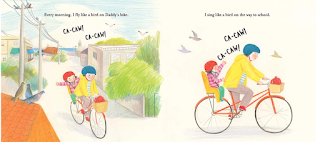 |
| Mary Quattlebaum |
Mary Quattlebaum is the author of 27 award-winning picture books, chapter books, novels, poetry, and nonfiction for children. Her most recent titles are Hero Dogs and Brother, Sister, Me and You. She teaches in the MFA program in writing for children and young adults at the Vermont College of Fine Arts, and at the Writer’s Center in Bethesda, MD. She reviews children’s books regularly for Washington Post/KidsPost and Washington Parent and speaks frequently at schools and conferences.
I talked to Mary about her career in children’s literature. Here’s a peek into her busy life.
You’ve had a varied career in children’s literature, writing, teaching, and reviewing books for children. Is there one of those “jobs” you love most—or is it the variety that inspires you?
I really enjoy the variety of what I do: writing, teaching, reviewing, and speaking. I find that I glean insights from each that help me grow and improve in the others. I’m grateful to be part of a community filled with people who work hard to share beauty, playfulness, and emotional truth with children.
How did you get started in the field of children’s literature?
What was your favorite book to write and why?
That is such a tough question! I loved writing all my books—for different reasons. My favorites: Pirate vs. Pirate, because I was inspired by my husband’s request to write a pirate book, which I did as a playful piratical love story and dedicated to him. I loved visiting the country landscape of my childhood with the three Jo MacDonald narrative nonfiction picture books. They made me think about my dad, who so generously shared his knowledge of the natural world with his children and grandchildren. Mighty Mole and Super Soil holds a special place in my heart because I am a huge fan of moles, who truly are the superheroes of the animal kingdom. My most recent nonfiction picture book—Brother, Sister, Me and You—is about animal siblings and is dedicated to my six sisters and brothers. I loved researching and exploring the connections that animals have with their siblings.
As a teacher, what’s your top tip for writers of children’s books?
To read widely, all genres of children’s books, and try writing in all of them. Take creative risks, try new forms and topics, follow your curiosity! Beginning writers seem to grapple with one of two personal challenges: They rarely finish a given project but instead go on to the next new shiny idea—or they tend to polish and polish one manuscript, hoping it will sell. The students and writers I know who continue to develop and publish are able to balance these two tendencies. They recognize the importance of bringing a project to completion and stringently revising it, but they also know the value of moving beyond one project to grow by embracing new material and engaging with new elements of craft.
As a reviewer, what qualities make a book for children stand out?
For me, what truly makes a book shine is quality of language. I’ve found that if a writer finesses sentences, attends to word choice, and plays with sound … s/he also tends to be diligent with character, plot, setting, and theme. I remember as a kid going back to re-read poems or passages just to savor the language. That’s how I discovered Elizabeth Bishop, in a big anthology of poetry for children. The images in her poem, “The Fish,” were so precise and amazing that—well, I was hooked as firmly as that eponymous creature.
Can you share a story from a child who’s been impacted by a book that you’ve written?
This happened after I had published only one or two books, and this boy’s comment has proved heartening over the years, as I, like all writers, deal with the ups and downs, disappointments and challenges of the business. During the Q&A at the end of a presentation, a fourth grader raised his hand and asked: “Who are your influences?” I had noticed this boy—quiet and very focused—during my talk and guessed he might be a writer, too. So I asked him: “And who are your influences?” He answered, rather shyly: “Now you are.” I was touched by his response and the thought that my book had connected like that with a reader.
And here’s my favorite funny comment:
After a school presentation, I found a note written by a child on a table displaying my books. It read: “I thought this was going to be really boring but I was wrong!!!” Yes, there were at least three exclamation points and even a few hearts.
Finally, at this time of year, readers are looking for books to give as gifts for Christmas. Would you be willing to share some titles?
So many amazing books in 2020! Here are some of my top choices:
Picture books: You Matter, a poetic celebration of the interconnection of life by Caldecott Honoree Christian Robinson.
Nonfiction: Condor Comeback by Sibert winner Sy Montgomery.
Middle-grade Graphic Novel: Twins, a lively coming-of-age graphic novel by Varian Johnson and Shannon Wright.
Middle-grade novel: A Whale of the Wild, a compelling drama about the undersea world of orcas, by Rosanne Parry.
YA: Stamped: Racism, Antiracism, and You, a timely, informative book by two of America’s most important writers Jason Reynolds and Ibram X. Kendi.
Thank you, Mary, for sharing your insights!
For more 2020 book ideas, visit the Washington Post’s list of Best Books for Children at:
Visit Mary on the web at www.maryquattlebaum.com






















